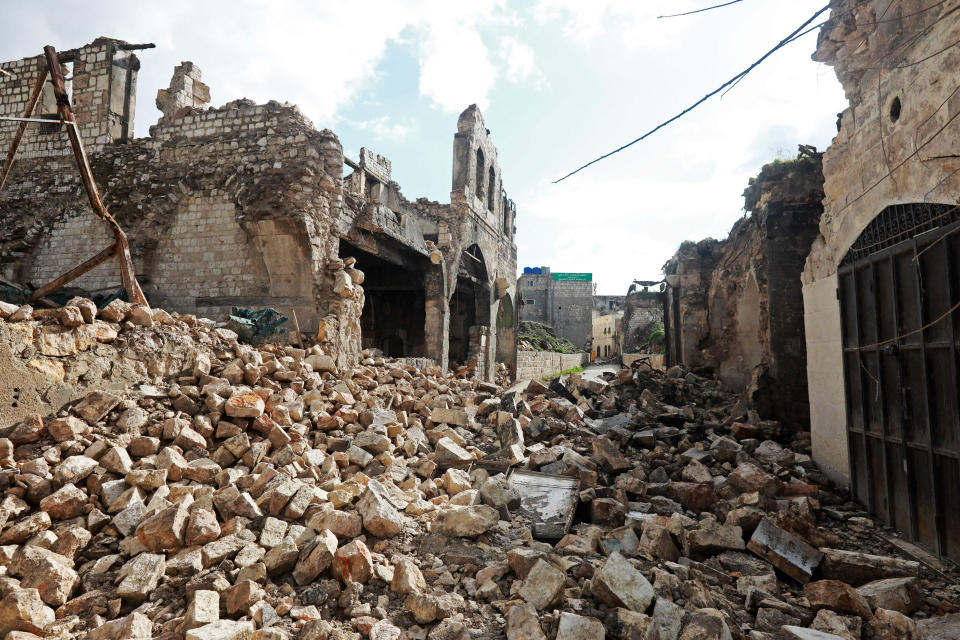Earthquakes damage historic sites in Turkey and Syria
From a castle in Gaziantep to a citadel in Aleppo, as rescuers search desperately for survivors after the devastating earthquakes in Turkey and Syria, concerns were also growing Tuesday for some of the region's most cherished historic sites.
UNESCO, the United Nations cultural agency, said in a statement that it was carrying out a survey of the affected areas and discovered many had either been damaged or collapsed completely.
"My condolences go out to the families and loved ones of those who died. My thoughts are also with the injured and all those affected. Our Organization will provide assistance within its mandate," UNESCO Director-General Audrey Azoulay said in the statement.
But the agency is worried too about the region's precious heritage.
The ancient Syrian city of Aleppo, where towers and walls have survived ancient and modern wars, has been badly affected. The city's famous Citadel, a World Heritage Site, was damaged; it had only recently been repaired following the fierce street fighting of the battle for Aleppo in 2012, part of the long-running and still ongoing civil war in the country.
Most of what was left of the Citadel was built in the 12th and 13th centuries A.D. by the Ayyubid dynasty — founded by Saladin, famed for his battles with the Christian Crusaders — but it bears the marks of the Greek, Roman, Byzantine and Ottoman empires.
The western tower of the old city wall has collapsed and several buildings in the souks — ancient marketplaces — have been weakened, the agency said.


In Turkey, UNESCO said several buildings in the Kurdish-majority city of Diyarbakır in the country's southeast had collapsed, raising fears for the Diyarbakır Fortress and the Hevsel Gardens Cultural Landscape, another World Heritage Site.
In the Upper Tigris River Basin, the fortress is of huge historical importance having played a role in times of Greek, Roman, Islamic and Ottoman rule. Its 3.6 miles of city walls remain a popular tourist attraction, thought to be second in size only to the Great Wall of China.
The agency also expressed concerns for the mysterious stone structures at Göbekli Tepe in the Anatolian mountains, which date between 9600 and 8200 B.C.; Nemrut Dağ, a temple-tomb in southeastern Turkey built in the first century B.C. by King Antiochus as a tribute to himself, and the 30-meter-tall Arslantepe Mound near the eastern city of Malatya, which was inhabited from the 6th millennium B.C. to the medieval times.
"UNESCO is mobilizing its experts ... to establish a precise inventory of the damage with the aim of rapidly securing and stabilizing these sites," the agency said.
One of the first major sites to show signs of damage was the imposing castle in the center of the city of Gaziantep in southeastern Turkey — not far from the epicenter of Monday's first devastating earthquake.
The castle, which sits on a site that can be traced back to the ancient Hittite Empire, has been left partially in ruins.
The state-run news agency Anadolu reported that bastions, the part of a castle wall jutting outward, had been "destroyed" on the east, south and southeastern sides, with the debris spilling on to the road.
The castle was developed and expanded by the Romans in the 2nd and 3rd centuries A.D. The Byzantine Empire in the 6th century gave the castle its lasting guise by adding the walls and 12 towers surrounding the inner keep.

A popular tourist spot, the remarkably well-preserved castle also housed the Gaziantep Defense and Heroism Panoramic Museum, which told the story of the site’s central role in the Turkish war of independence following World War I.
The most recent renovation began in 2020, when a series of ancient underground tunnels was discovered. Plans were underway to open the tunnels to tourists this year.
Turkey's rich Islamic architecture has suffered drastically from the quakes — including one mosque that is no stranger to natural disasters.
The Yeni Camii, or New Mosque, in Malatya partially collapsed in the tremors Monday, its great domes lying in ruin.
The mosque had only just recovered and reopened for worship after suffering damage in a 2020 earthquake. The mosque stands on the site of the Hacı Yusuf Mosque, which was itself destroyed by an earthquake in 1893.
This article was originally published on NBCNews.com

 money
money 